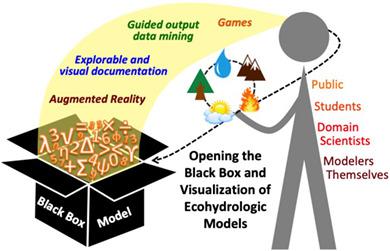当前位置:
X-MOL 学术
›
Hydrol. Process.
›
论文详情
Our official English website, www.x-mol.net, welcomes your
feedback! (Note: you will need to create a separate account there.)
Visualization and ecohydrologic models: Opening the box
Hydrological Processes ( IF 2.8 ) Pub Date : 2020-11-24 , DOI: 10.1002/hyp.13991 Christina Tague 1 , James Frew 1
Hydrological Processes ( IF 2.8 ) Pub Date : 2020-11-24 , DOI: 10.1002/hyp.13991 Christina Tague 1 , James Frew 1
Affiliation

|
Earth system models synthesize the science of interactions amongst multiple biophysical and, increasingly, human processes across a wide range of scales. Ecohydrologic models are a subset of earth system models that focus particularly on the complex interactions between ecosystem processes and the storage and flux of water. Ecohydrologic models often focus at scales where direct observations occur: plots, hillslopes, streams, and watersheds, as well as where land and resource management decisions are implemented. These models complement field‐based and data‐driven science by combining theory, empirical relationships derived from observation and new data to create virtual laboratories. Ecohydrologic models are tools that managers can use to ask “what if” questions and domain scientists can use to explore the implications of new theory or measurements. Recent decades have seen substantial advances in ecohydrologic models, building on both new domain science and advances in software engineering and data availability. The increasing sophistication of ecohydrologic models however, presents a barrier to their widespread use and credibility. Their complexity, often encoding 100s of relationships, means that they are effectively “black boxes,” at least for most users, sometimes even to the teams of researchers that contribute to their design. This opacity complicates the interpretation of model results. For models to effectively advance our understanding of how plants and water interact, we must improve how we visualize not only model outputs, but also the underlying theories that are encoded within the models. In this paper, we outline a framework for increasing the usefulness of ecohydrologic models through better visualization. We outline four complementary approaches, ranging from simple best practices that leverage existing technologies, to ideas that would engage novel software engineering and cutting edge human–computer interface design. Our goal is to open the ecohydrologic model black box in ways that will engage multiple audiences, from novices to model developers, and support learning, new discovery, and environmental problem solving.
中文翻译:

可视化和生态水文模型:打开盒子
地球系统模型综合了多种生物物理以及越来越广泛的人类过程之间相互作用的科学。生态水文模型是地球系统模型的子集,特别关注生态系统过程与水的存储和通量之间的复杂相互作用。生态水文模型通常关注发生直接观测的尺度:地块,山坡,溪流和流域,以及执行土地和资源管理决策的尺度。这些模型通过将理论,从观测获得的经验关系与新数据相结合来创建虚拟实验室,从而对基于现场和数据驱动的科学进行了补充。生态水文模型是管理者可以用来问“如果”的问题的工具,领域科学家可以用来探索新理论或新方法的含义的工具。最近几十年来,基于新的领域科学以及软件工程和数据可用性的进步,生态水文模型取得了长足的进步。然而,生态水文模型的日益复杂,为它们的广泛使用和可信度构成了障碍。它们的复杂性通常会编码上百个关系,这意味着它们实际上是“黑匣子”,至少对于大多数用户而言,有时甚至是对设计有所贡献的研究人员团队而言。这种不透明使模型结果的解释变得复杂。为了使模型有效地增进我们对植物与水之间相互作用的理解,我们不仅要改善对模型输出的可视化,而且还要对模型中编码的基础理论进行可视化。在本文中,我们概述了一个框架,可通过更好的可视化来提高生态水文模型的实用性。我们概述了四种补充方法,从利用现有技术的简单最佳实践,到可以进行新颖的软件工程和前沿的人机界面设计的想法。我们的目标是以使新手到模型开发者广泛参与的方式打开生态水文模型黑匣子,并支持学习,新发现和环境问题解决。我们概述了一个框架,可通过更好的可视化来提高生态水文模型的实用性。我们概述了四种补充方法,从利用现有技术的简单最佳实践,到可以进行新颖的软件工程和尖端的人机界面设计的想法。我们的目标是以使新手到模型开发者广泛参与的方式打开生态水文模型黑匣子,并支持学习,新发现和环境问题解决。我们概述了一个框架,可通过更好的可视化来提高生态水文模型的实用性。我们概述了四种补充方法,从利用现有技术的简单最佳实践,到可以进行新颖的软件工程和尖端的人机界面设计的想法。我们的目标是以使新手到模型开发者广泛参与的方式打开生态水文模型黑匣子,并支持学习,新发现和环境问题解决。
更新日期:2021-01-26
中文翻译:

可视化和生态水文模型:打开盒子
地球系统模型综合了多种生物物理以及越来越广泛的人类过程之间相互作用的科学。生态水文模型是地球系统模型的子集,特别关注生态系统过程与水的存储和通量之间的复杂相互作用。生态水文模型通常关注发生直接观测的尺度:地块,山坡,溪流和流域,以及执行土地和资源管理决策的尺度。这些模型通过将理论,从观测获得的经验关系与新数据相结合来创建虚拟实验室,从而对基于现场和数据驱动的科学进行了补充。生态水文模型是管理者可以用来问“如果”的问题的工具,领域科学家可以用来探索新理论或新方法的含义的工具。最近几十年来,基于新的领域科学以及软件工程和数据可用性的进步,生态水文模型取得了长足的进步。然而,生态水文模型的日益复杂,为它们的广泛使用和可信度构成了障碍。它们的复杂性通常会编码上百个关系,这意味着它们实际上是“黑匣子”,至少对于大多数用户而言,有时甚至是对设计有所贡献的研究人员团队而言。这种不透明使模型结果的解释变得复杂。为了使模型有效地增进我们对植物与水之间相互作用的理解,我们不仅要改善对模型输出的可视化,而且还要对模型中编码的基础理论进行可视化。在本文中,我们概述了一个框架,可通过更好的可视化来提高生态水文模型的实用性。我们概述了四种补充方法,从利用现有技术的简单最佳实践,到可以进行新颖的软件工程和前沿的人机界面设计的想法。我们的目标是以使新手到模型开发者广泛参与的方式打开生态水文模型黑匣子,并支持学习,新发现和环境问题解决。我们概述了一个框架,可通过更好的可视化来提高生态水文模型的实用性。我们概述了四种补充方法,从利用现有技术的简单最佳实践,到可以进行新颖的软件工程和尖端的人机界面设计的想法。我们的目标是以使新手到模型开发者广泛参与的方式打开生态水文模型黑匣子,并支持学习,新发现和环境问题解决。我们概述了一个框架,可通过更好的可视化来提高生态水文模型的实用性。我们概述了四种补充方法,从利用现有技术的简单最佳实践,到可以进行新颖的软件工程和尖端的人机界面设计的想法。我们的目标是以使新手到模型开发者广泛参与的方式打开生态水文模型黑匣子,并支持学习,新发现和环境问题解决。











































 京公网安备 11010802027423号
京公网安备 11010802027423号